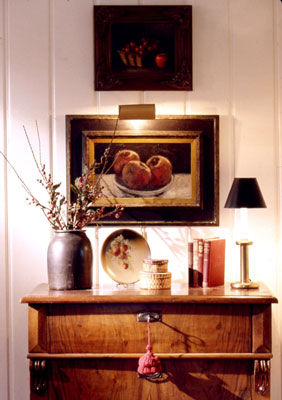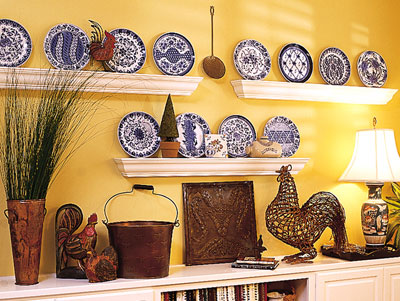Personalize with Accessories

Let the decorating experts from Better Homes and Gardens® magazines help you finish off your home with style!
Decorative accessories are like jewelry for your home – the finishing touch that completes the look with a satisfying flourish. In home decorating, accessories include essentials such as lamps, pillows, and area rugs as well as all the objects you collect to hang on walls, arrange on shelves, and display on tabletops. They’re usually the last things to be placed when you’re redecorating a room, but that doesn’t make them the least significant; accessories add color and texture to rooms, and even more important, they tell your story, reflecting your interests and what you enjoy or cherish.
When you arrange accessories, you’re composing a still life. To make it as pleasing as possible, pay attention to repetition, variety, balance, and scale. The principles apply whether you’re arranging a collection of vases on a shelf, porcelain boxes on a tabletop, or paintings on a wall. (In fact, the same rules guide how you place furniture in a room.) Working with accessories is fun because you can continually arrange and rearrange, giving yourself new focal points as often as you like.
As you decorate, you may worry about where the sofa should go, or fret about the window treatments. But true decorating anxiety really bubbles over when you start selecting and placing accessories. To make accessories really shine in a room, consider them from the very beginning of your decorating plan. Sometimes an accessory or a collection even directs the decor. Conversely, if you’ve collected a few too many items, you may need to get rid of or store some. Decorating writers call this "editing." Decorating is the opportunity to evaluate these items and keep only those that still hold meaning for you and that will look good in a room.
Take a three-pronged approach when choosing and displaying accessories based on location, location, location: deciding what goes on the walls, on tables, and on the mantel. That, of course, succinctly covers the territory.
Accessories for the Wall

The most frequently used wall decoration is framed pictures. That, however, is no constraint to your choices. The images, how they’re grouped and framed, and the wall coverings behind them all have an impact in a room. Create balance in your wall displays. Find the centerline of your display (over the mantel or the center of the sofa, for example); if the placement of images on one side of that center line mirrors the placement of items on the other, the arrangement is symmetrical. If there are more images on one side, or they’re at varying heights, the arrangement is asymmetrical. Either way, the visual "weight" of the grouping should be equal.
Using a single large image dominates a wall and simplifies the look. Choose a large image to play up on a room’s color scheme and add to the desired sense of calm in a room.
Of course, not all wall decor is initially chosen with room decor in mind. A collection requires the right place for display. Designate an area large enough to show a collection; if you’re still collecting, think of other places for display or plan for flexibility to rotate items.
Accessories for Tables
There are two kinds of accessories... those that are purely decorative and hold their usefulness in the satisfaction beauty always gives, in the necessity of mankind for more than pure function. Then there are the accessories that perform a direct service for you, but contain and reflect beauty as well. For both kinds of accessories, proportion and function are key.
An abundance of small items will crowd a tabletop and look messy. Big items leave no room for anything else. If someone will regularly be setting items on the table (papers, a remote or two, glasses), leave room for these items so no one needs to push things around to make room or to find things. The tabletop is one area where less is almost always more.

Accessories for the Mantel
Decorating the mantel involves decorating the whole fireplace wall. In many instances, the fireplace is the dominant point in the room, so what’s on the mantel (or above it) is prominent in the room. Choose accessories for the mantel that relate particularly well to the space and put extra thought into the size. Items need to be substantial enough for this spot, but shouldn’t overpower the room. For example, a large, very active picture that covered the entire wall above the fireplace could look as though it would topple over, but a grouping of images can cover the same amount of space and is visually pleasing.
At the other extreme, avoid items that are too small. Even if you keep things simple, such as the three pieces of pewter on the mantel in the Colonial-style room, the items should contrast with the background and keep the mantel from looking empty. Don’t cover the whole mantel with little accessories marching across the front. Try varying the sizes and layer smaller accessories in front of bigger pieces.

Large pictures and mirrors do not always have to be hung. Try leaning them against the wall above the fireplace. This decorative trick can also work on a buffet or hutch. Note: for safety reasons, secure it to the wall.
Bookshelves over or next to the fireplace are another pleasing option. This option puts the books you’ll be reading in a place you’d like to read them – next to the fireplace – and gives you lots of decorating options. Break up the march of books stacked on the shelves library style with decorative items, plants, and books stacked on their sides.
Enjoy decorating with accessories! Accessories can be a cost-effective way to change with the the seasons, too.
© 2007 Meredith Corporation